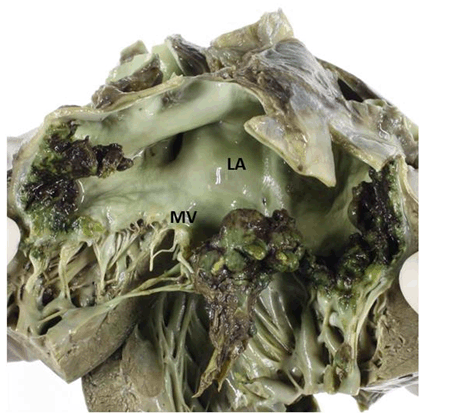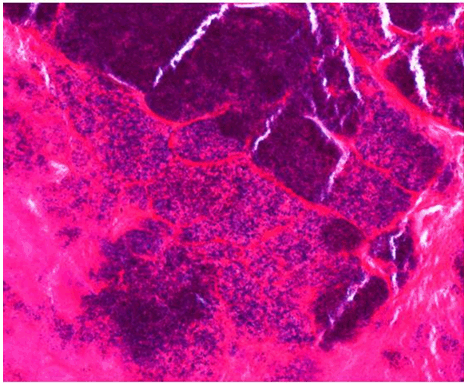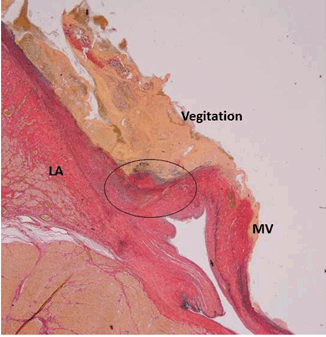
|
 |
|
Case Report
| ||||||
| Fatal outcome in a case of infective endocarditis due to delay in diagnosis and the autopsy findings | ||||||
| Junji Matsuda1,2, Ryo Kojima1, Yutaka Matsumura1, Junichi Nitta1 | ||||||
|
1MD, Cardiovascular Medicine, Japan Red Cross Saitama Hospital, Saitama, Japan; 2MD, Department of Cardiovascular Medicine, Tokyo Medical and Dental University, Tokyo, Japan 2MD, Department of Cardiovascular Medicine, Tokyo Medical and Dental University, Tokyo, Japan | ||||||
| ||||||
|
[HTML Abstract]
[PDF Full Text]
[Print This Article] [Similar article in Pumed] [Similar article in Google Scholar] 
|
| How to cite this article |
| Matsuda J, Kojima R, Matsumura Y, Nitta J. Fatal outcome in a case of infective endocarditis due to delay in diagnosis and the autopsy findings. Int J Case Rep Images 2017;8(10):627–630. |
|
ABSTRACT
| ||||||
|
Introduction: Infective endocarditis is an infection of a heart valve or other cardiac structure at a site of endothelial damage. Infective endocarditis is associated with a broad array of complications and has a high fatality rate. Some autopsy case reports regarding causes of death have previously been published. These cases reported that the condition of patients with infective endocarditis worsened drastically, and they suddenly died from fatal complications, such as acute severe heart failure, cerebrovascular major embolism, and hemorrhage or acute coronary embolism. In these cases, early diagnosis did not necessarily have an important role because of the unpredictable and relatively rare situation. Keywords: Autopsy, Early diagnosis, Infective endocarditis, Multi-organ failure | ||||||
|
INTRODUCTION
| ||||||
|
Infective endocarditis is an infection of a heart valve or other cardiac structure at a site of endothelial damage. The definition of infective endocarditis has been also expanded to include infected cardiac devices. A variety of organ systems may be adversely affected in patients with infective endocarditis. Although advances have improved the diagnostic accuracy, infective endocarditis has relatively high morbidity and mortality rates from 16–25% of affected individuals [1][2][3][4]. Infective endocarditis is associated with a broad array of a complications; cardiac, neurologic, renal, musculoskeletal, and systemic complications related to the infection (embolization, metastatic infection, and aneurysm) [5][6]. Some autopsy case reports regarding causes of death have previously been published. These cases reported that the condition of patients with infective endocarditis worsened drastically, and they suddenly died from fatal complications, such as acute severe heart failure, cerebrovascular major embolism, and hemorrhage or acute coronary embolism [6][7][8][9][10][11][12][13]. In these cases, early diagnosis did not necessarily have an important role because of the unpredictable and relatively rare situation. We report a case of a 47-year-old male with infective endocarditis; early diagnosis could have avoided his unfortunate death. We report this case to emphasize the importance of early diagnosis of infective endocarditis. | ||||||
|
CASE REPORT
| ||||||
|
A 47-year-old male was transferred to our hospital due to fever and severe fatigue. Although he had been experiencing symptoms for several months and visited doctors near his home several times, his condition was not diagnosed and he took antimicrobial drugs for a few days. On admission, he exhibited a systolic murmur and moderate mitral regurgitation with large vegetation on echocardiographic findings (Figure 1). Streptococcus mitis was detected in his blood culture and he was diagnosed with infective endocarditis. He also exhibited Janeway lesion, petechial hemorrhage on his conjunctiva and Roth spots on his fundus (Figure 2). His clinical presentation is typical. Computed tomography scan and magnetic resonance imaging scan revealed small multiple embolization to the brain, spleen, and kidney. Cardiac surgery was too risky because he also had severe coagulopathy and his mitral regurgitation was not so severe as needed the surgery. Although intensive medical treatment was administered, his severe infection was not controlled, and it led to multi-organ failure. On day-15 of hospitalization, the patient succumbed to multi-organ failure. Autopsy revealed huge vegetation (30×15×5 mm) in the two-thirds around the mitral valve (Figure 3). Histological analysis demonstrated that the vegetation was composed of necrotic tissue and neutrophils, along with numerous Gram-positive cocci (Figure 4) that destroyed the tissue of the mitral valve and the wall of the left atrium (Figure 5). An autopsy also revealed embolization of kidney and spleen and necrotic intestines, which had caused multi-organ failure. | ||||||
| ||||||
| ||||||
| ||||||
| ||||||
| ||||||
|
DISCUSSION
| ||||||
|
This case illustrates the fatal outcome of undiagnosed infective endocarditis in a patient who did not have fatal complications, such as acute heart failure, cerebrovascular major embolism, and hemorrhage or acute coronary embolism, which have been reported in past cases. Infective endocarditis is associated with a broad array of a complications; cardiac, neurologic, renal, musculoskeletal, and systemic complications related to the infection (embolization, metastatic infection, and aneurysm) [5][6]. Some autopsy case reports regarding causes of death, which are due to fatal complications, have previously been published [7][10][11][14]. In this case, although the patient did not have fatal complications which have been reported in past such cases, he subsequently died as a result of this uncontrollable infection. On admission, intensive medical treatment was administered; antibiotics, renal replacement therapy and blood transfusion. He also had disseminated intravascular coagulation, which is one of the complication of infective endocarditis [15]. Cardiac surgery was too risky because of severe coagulopathy. We think he had best medical treatment in hospital. In present case, delay in diagnosis of infective endocarditis caused his unfortunate death. Clinical presentation on admission was relatively typical. Conservative antimicrobial treatment for undiagnosed fever causes delays in the diagnosis of infective endocarditis. Once infective endocarditis has progressed it is too late to control the infection and recover systemic organ failure even though fatal complications are not a problem. In this case, early diagnosis could have avoided the unfortunate outcome. We report this case to emphasize the importance of early diagnosis of infective endocarditis. | ||||||
|
CONCLUSION
| ||||||
|
Delays in the diagnosis of infective endocarditis resulted in a fatal outcome despite absence of fatal complications such as acute heart failure, cerebrovascular major embolism, and hemorrhage or acute coronary embolism. Early diagnosis of infective endocarditis is crucial. | ||||||
|
REFERENCES
| ||||||
| ||||||
|
[HTML Abstract]
[PDF Full Text]
|
|
Acknowledgements
We would like to thank Editage for English language editing. |
|
Author Contributions
Junji Matsuda – Substantial contributions to conception and design, Acquisition of data, Analysis and interpretation of data, Drafting the article, Revising it critically for important intellectual content, Final approval of the version to be published Ryo Kojima – Substantial contributions to conception and design, Drafting the article, Final approval of the version to be published Yutaka Matsumura – Substantial contributions to conception and design, Drafting the article, Final approval of the version to be published Junichi Nitta – Substantial contributions to conception and design, Drafting the article, Final approval of the version to be published |
|
Guarantor
The corresponding author is the guarantor of submission. |
|
Source of support
None |
|
Conflict of interest
Authors declare no conflict of interest. |
|
Copyright
© 2017 Junji Matsuda et al. This article is distributed under the terms of Creative Commons Attribution License which permits unrestricted use, distribution and reproduction in any medium provided the original author(s) and original publisher are properly credited. Please see the copyright policy on the journal website for more information. |
|
|








